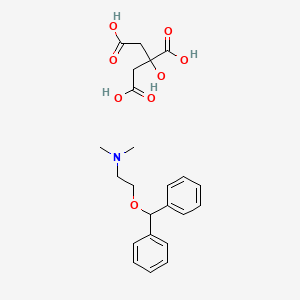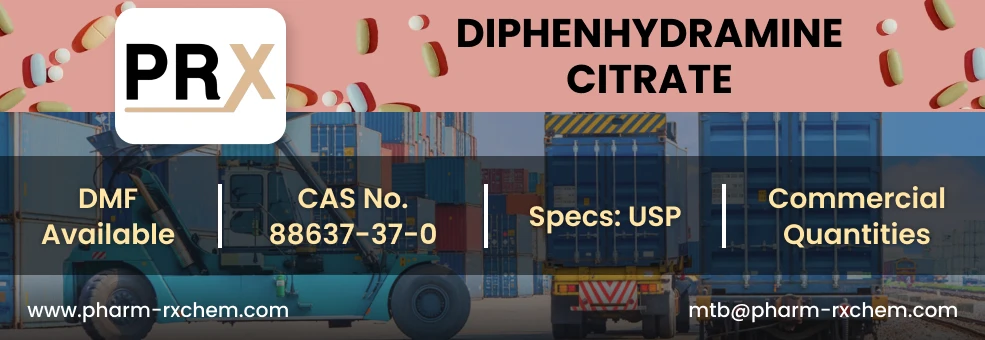



1. 2-diphenylmethoxy-n,n-dimethylethylamine
2. Allerdryl
3. Benadryl
4. Benhydramin
5. Benylin
6. Benzhydramine
7. Citrate, Diphenhydramine
8. Dimedrol
9. Diphenhydramine
10. Diphenhydramine Citrate (1:1)
11. Diphenhydramine Hydrochloride
12. Diphenylhydramin
13. Diphenylhydramine
14. Dormin
15. Hydrochloride, Diphenhydramine
1. 88637-37-0
2. 2-(benzhydryloxy)-n,n-dimethylethanamine 2-hydroxypropane-1,2,3-tricarboxylate
3. Diphenhydramine Citrate [usp]
4. Diphenhydramine (citrate)
5. 2-benzhydryloxy-n,n-dimethylethanamine;2-hydroxypropane-1,2,3-tricarboxylic Acid
6. 4od433s209
7. 2-(diphenylmethoxy)-n,n-dimethylethylamine Citrate (1:1)
8. Diphenhydramine Citrate (usp)
9. Ethanamine, 2-(diphenylmethoxy)-n,n-dimethyl-, 2-hydroxy-1,2,3-propanetricarboxylate (1:1)
10. Unii-4od433s209
11. Einecs 289-432-0
12. Schembl322306
13. Chembl1201089
14. Dtxsid80237211
15. Bcp12478
16. 2-(benzhydryloxy)-n,n-dimethylethanamine2-hydroxypropane-1,2,3-tricarboxylate
17. Akos016005048
18. Diphenhydramine Citrate [mart.]
19. Diphenhydramine Citrate [vandf]
20. 2-benzhydryloxy-n,n-dimethylethanamine,2-hydroxypropane-1,2,3-tricarboxylic Acid
21. Diphenhydramine Citrate [usp-rs]
22. Diphenhydramine Citrate [who-dd]
23. Diphenhydramine Citrate [orange Book]
24. D03854
25. Diphenhydramine Citrate [usp Monograph]
26. 637d370
27. Q5402419
28. (2-(diphenylmethoxy)ethyl)dimethylammonium Dihydrogen 2-hydroxypropane-1,2,3-tricarboxylate
| Molecular Weight | 447.5 g/mol |
|---|---|
| Molecular Formula | C23H29NO8 |
| Hydrogen Bond Donor Count | 4 |
| Hydrogen Bond Acceptor Count | 9 |
| Rotatable Bond Count | 11 |
| Exact Mass | 447.18931688 g/mol |
| Monoisotopic Mass | 447.18931688 g/mol |
| Topological Polar Surface Area | 145 Ų |
| Heavy Atom Count | 32 |
| Formal Charge | 0 |
| Complexity | 439 |
| Isotope Atom Count | 0 |
| Defined Atom Stereocenter Count | 0 |
| Undefined Atom Stereocenter Count | 0 |
| Defined Bond Stereocenter Count | 0 |
| Undefined Bond Stereocenter Count | 0 |
| Covalently Bonded Unit Count | 2 |
Histamine H1 Antagonists
Drugs that selectively bind to but do not activate histamine H1 receptors, thereby blocking the actions of endogenous histamine. Included here are the classical antihistaminics that antagonize or prevent the action of histamine mainly in immediate hypersensitivity. They act in the bronchi, capillaries, and some other smooth muscles, and are used to prevent or allay motion sickness, seasonal rhinitis, and allergic dermatitis and to induce somnolence. The effects of blocking central nervous system H1 receptors are not as well understood. (See all compounds classified as Histamine H1 Antagonists.)
Anesthetics, Local
Drugs that block nerve conduction when applied locally to nerve tissue in appropriate concentrations. They act on any part of the nervous system and on every type of nerve fiber. In contact with a nerve trunk, these anesthetics can cause both sensory and motor paralysis in the innervated area. Their action is completely reversible. (From Gilman AG, et. al., Goodman and Gilman's The Pharmacological Basis of Therapeutics, 8th ed) Nearly all local anesthetics act by reducing the tendency of voltage-dependent sodium channels to activate. (See all compounds classified as Anesthetics, Local.)
Sleep Aids, Pharmaceutical
Drugs used to induce SLEEP, prevent SLEEPLESSNESS, or treat SLEEP INITIATION AND MAINTENANCE DISORDERS. (See all compounds classified as Sleep Aids, Pharmaceutical.)
Anti-Allergic Agents
Agents that are used to treat allergic reactions. Most of these drugs act by preventing the release of inflammatory mediators or inhibiting the actions of released mediators on their target cells. (From AMA Drug Evaluations Annual, 1994, p475) (See all compounds classified as Anti-Allergic Agents.)
Antiemetics
Drugs used to prevent NAUSEA or VOMITING. (See all compounds classified as Antiemetics.)
Hypnotics and Sedatives
Drugs used to induce drowsiness or sleep or to reduce psychological excitement or anxiety. (See all compounds classified as Hypnotics and Sedatives.)
